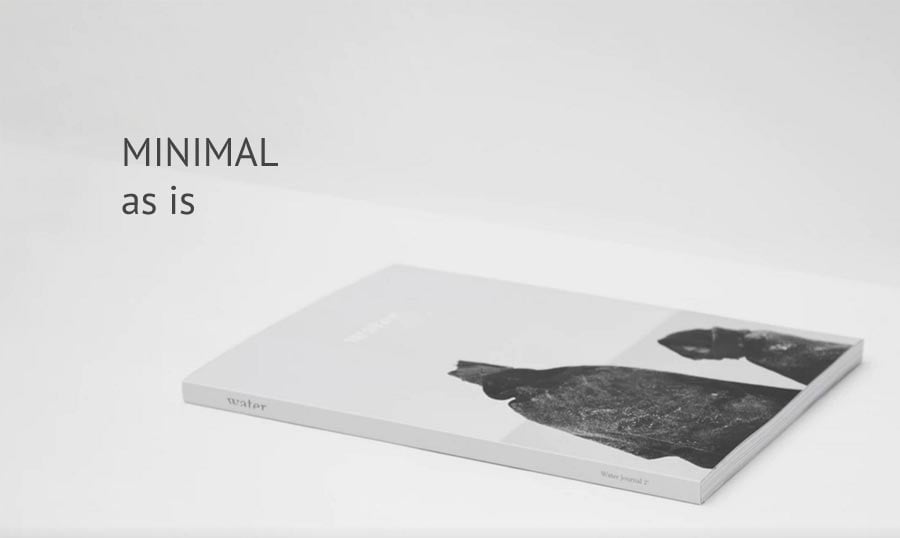We’ve all seen minimalist websites that look good but don’t really have anything in terms of substantive content.
That begs the question, is a minimalist website really effective if it doesn’t provide any value to the end user? What we, as designers, should really be focused on is designing pages that are minimalist on the surface and functional deep down.
Why Minimalism?
White space, simplicity, and refined typography…oh, my!
It’s hard to click on any website these days and not see at least fine traces of minimalist design. Minimalism is not a new concept – it’s been around for centuries – but it is going through a sort of revitalization.
For the first time ever, it’s become a popular approach to web design.
In order to grasp the allure of minimalism for designers, brands, and customers, you have to understand what it does. In essence, it puts the emphasis on simplicity. Any element that doesn’t add value to the user experience is stripped away so that visitors are only exposed to the ones that matter.
Generally, color and typography are used to emphasize the simplistic nature of the design, while one or two primary elements – such as a banner image, video, or call-to-action – are intended to receive most of the attention.
Minimalist design is taking over because it just works. The style is so simple that users don’t have to think about it. Even though it requires quite a bit of thought and planning from designers to create something that looks so easy.
Carrie Cousins, web designer.
There are a number of benefits associated with pursuing minimalism in web design. For one, it helps to crystallize the page’s focus and purpose by eliminating distractions. Secondly, it’s crazy fast. When you strip away the elements that don’t add value, suddenly you have a lightweight site that loads fast. The result is lower bounce rates and more satisfied visitors.
The result is lower bounce rates and more satisfied visitors.
The Keys to Functional Minimalism in Web Design
But the problem with most minimalist website designs is that they lack functionality.
So much is stripped away that there’s nothing left for visitors to sink their teeth into. The result tends to be an aesthetically pleasing website with a shallow user experience.
As Cousins says, “Minimalist design can be identified by a framework that is simple in nature. Only necessary elements for functionality are included in the design.”
The key word in that last sentence is “necessary elements.”
Designers often remove all functionality when it comes to designing minimalist sites – an approach that’s flawed. At the heart of minimalism is a reliance on functionality. (Simple functionality, but functionality, nonetheless.)
The classic Google homepage is an excellent example of a minimalist design that retains its functionality.
While 95% of the page is nothing but whitespace, it’s still very much a functional page.
You can easily conduct a web search using the search box in the middle. You can access your Gmail account using the small link in the corner. There’s even a menu that allows you to quickly access the different Google tools. This is functional minimalism at its best.
Another relevant example of functional minimalism is the Consultants 500 homepage.
Notice how – above the fold – the page features very little text or explanations on the services available, yet you can easily grasp the focus of the site. The tagline “Get more done with Consultants 500,” followed by a search box, clearly tells visitors what the site is about. Then, instead of providing meaty descriptions for all of the business services offered, the page simply features clean, flat icons for each.
Strike a Balance
Web designer and conversion expert Sherice Jacob has an interesting theory on functionality and site design. In her experience, she’s discovered that the former matters more than the latter. It’s possible to have a functional site that happens to be ugly and successful. (Think Craigslist and eBay.)
It’s far more difficult to be successful if you have an aesthetically pleasing site that lacks functionality. As soon as people start digging around, they’ll realize that there’s nothing of value for them.
The problem is that most designers and brands focus so much on the aesthetic properties of minimalism that they fail to consider the importance of functionality. The result is a lot of breathtaking websites that have nothing beneath the surface. And in the end, these sites stand no chance of being successful.
If you want to get homepage minimalism right without compromising functionality, you have to take a balanced approach. Don’t give more weight to one than the other. Understand that they work in unison to produce the desired result.
It may take a lot of additional time and effort to meticulously scrutinize each and every aspect of your homepage, but all of the work you put in on the front end will be well worth it down the road.
You can easily start your own minimal website using one of our minimal WordPress themes.
